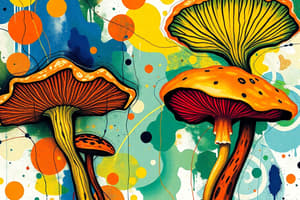Podcast
Questions and Answers
What is the sugar concentration in laboratory media suitable for fungi?
What is the sugar concentration in laboratory media suitable for fungi?
- 5-6%
- 3-4%
- 1-2%
- 4-5% (correct)
To which type of agents are fungi sensitive?
To which type of agents are fungi sensitive?
- Antiviral agents
- Antibacterial agents
- Antifungal agents (correct)
- Antiparasitic agents
What do fungal cell membranes consist of?
What do fungal cell membranes consist of?
- Phospholipids
- Glycoproteins
- Ergosterol (correct)
- Cholesterol
Which drugs act on ergosterol in fungal cell membranes?
Which drugs act on ergosterol in fungal cell membranes?
What do all fungi require as a carbon source?
What do all fungi require as a carbon source?
Which type of cell do fungi have?
Which type of cell do fungi have?
What is the optimum pH range for fungal growth?
What is the optimum pH range for fungal growth?
Why are fungi insensitive to penicillins?
Why are fungi insensitive to penicillins?
What is chitin composed of?
What is chitin composed of?
Which component of the fungal cell wall is the target of some antifungal drugs?
Which component of the fungal cell wall is the target of some antifungal drugs?
Flashcards are hidden until you start studying
Study Notes
Characteristics of Fungi
- All fungi are saprophytes, requiring a preformed organic source of carbon for growth.
- Fungi have a unique cell membrane composition, featuring ergosterol instead of cholesterol, which is the site of action for antifungal drugs like amphotericin B and azole group.
Physiology of Fungi
- Fungi are aerobic, requiring oxygen for their development.
- All fungi are eukaryotic, having a true nucleus, unlike bacteria which are prokaryotic.
- Fungi have an optimal pH range for growth between 3.8-5, and an optimal temperature range of 22-28°C.
Cell Wall Structure
- Fungal cell walls contain large amounts of chitin and cellulose, but do not contain peptidoglycan, making them insensitive to antibiotics like penicillins.
- Chitin is a polysaccharide composed of long chains of N-acetylglucosamine.
- The fungal cell wall also contains β-glucan, which is the site of action for some antifungal drugs.
Nutritional Requirements
- Fungi require a preformed organic source of carbon, often associated with decaying matter.
- Sugars are concentrated in laboratory media at 4-5% (compared to 1.5% for bacteria).
Antibiotic Sensitivity
- Fungi are sensitive to antifungal agents only, and are not affected by antibiotics that target bacterial cell walls.
Studying That Suits You
Use AI to generate personalized quizzes and flashcards to suit your learning preferences.




